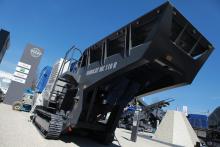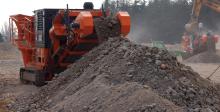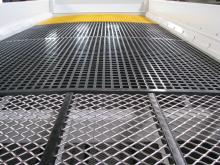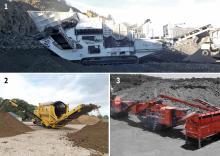
The choice of mobile or static crushing equipment depends on the nature of the operation as Patrick Smith reports
The nature of the crushing and screening industry demands reliable machines that can deliver efficiency over long periods.
Equally as important is that the machines must be able to stand up to demanding conditions and heavy usage, be they mobile or static.
In recent years, quarry operations have been turning to mobile units which, being compact and self-driven, allow them to operate close to the quarry site, thereby curtailing the use of large conveyors belts and in turn offsetting recurring operating maintenance costs. They can usually be commissioned and dismantled in days, keeping residual losses at a minimum.
However, despite the many benefits provided by mobile plants, fixed crushing and screening plants often have an edge for operations in high output quarries that are operated over a number of years.
For example, if a plant has a throughput in excess of 500tonnes/hour, or 1 million tonnes/year, based on eight-hour days and five days/week, large fixed crushers and screens can prove the best option. Mobile plants would be ideal to meet aggregate throughput between 250-500tonnes/hour.
Major manufacturers supply both configurations, and following the market launch of its new generation of mobile impact crushers,
“When a new machine is developed from scratch, the moment of truth - the market launch - always strikes sooner or later, and no matter how well or how diligently the preparations and testing work may have been, this is a time when various questions arise,” say experts from Kleemann.
“In terms of performance and fuel consumption, both the MR 110 and the MR 130 have demonstrated what is possible in their size class when the right concept is applied. The new material flow concept, which ensures that there is no restriction to the flow of the material, successfully prevents the blockages, reduces wear and increases the performance of the entire plant.”
An MR 110 Z EVO plant has recently been used on recycling in Xuchang, Henan Province, China, crushing demolition material, where the feed material has an average size of 0-900mm (in some cases 1,000mm) and is crushed to a size of 0-32mm. It is recycled for use in the manufacture of various products, such as cement and bricks or used as a subgrade material in road construction. Performance tests are said to show feed capacities of as much as 350tonnes/hour.
According to David Zhao of
The MR 110 ZS EVO boasts a standalone double-deck grizzly, but also high-performance electromagnets and a screening unit including oversize grain return conveyor whose screen surface is 40% larger in comparison to the predecessor model. A fully hydraulic and automatic gap setting permits the crusher gap to be adjusted to the exact millimetre using the touch panel when the rotor is running.
“A safe operating environment is created by practical solutions. When service points can be reached easily, the possibility of dangerous situations diminishes,” says Timo Nakari, product manager with
The Lokotrack LT120 from Metso is built around the new C120 jaw crusher and uses the same field-proven technology seen in Metso’s tracked units for more than 26 years.
The electrically driven version, the Lokotrack LT120E, can draw its energy from either an external power supply or a 420kV on-board diesel generator.
“Good examples of safety built in to the LT120 include sturdy, easy-to-open, composite flywheel guards and hydraulically folding and locking feed hopper sides,” says Nakari.
Metso say the Lokotrack LT120 can be fine-tuned to suit particular applications by selecting various options, ranging from, for example, a long main conveyor and hammer and boom to a water-spraying system and rubber linings for the feeder and hopper.
The Lokotrack LT120 features a 310kW
The company’s HP3 cone crusher, which follows on from the HP4 and HP5 features the size of an HP200 with the output of an HP300.
“As the power, performance and robustness of the new generation models allow, in certain cases, the replacement of two crushers by just one, investment, production and operation costs are greatly reduced.”
The HP3 has been tested at two different quarry sites in France over the past seven months at a gravel pit and a rock quarry, and several orders have already been received for secondary and tertiary applications.
HP3 has a nominal feed opening of 220mm, a motor size of up to 220kW and it weighs 13,280kg.
Also in France,
“The new facelift features include a hydraulic folding hopper design which brings total transport height to under 3.4m. This was a key aspect of the sale, as strict transport guidelines are enforced for heights above this,” says Leon Connolly, sales and marketing manager.
“The new hydraulic folding hopper feature means the 623CT is even more ‘European friendly’ and can increase its presence for secondary and tertiary crushing.”
Weighing 26tonnes, it has an increased performance output of 150tonnes/hour and can be integrated into existing crushing and screening setups; can be used separately as a stand-alone unit or positioned as a secondary crusher after a primary jaw crusher. It can also be positioned under the oversize belt of most tracked screening plants to close the circuit.
Higher tonnages are available using the Tesab 1412T, which has the same design principle as the 623CT and can produce up to 350tonnes/hour.
When Austrian company
The crusher, the first QJ241 in Austria, was delivered to the Poysdorf-based company (60km north-east of the capital Vienna) in December, 2011, and now delivers as a flexible mobile unit for operation at Poyss’s construction sites, as well as in a fixed role at the certified Niederabsdorf recycling plant.
Established more than 80 years ago as a transport company, Poyss now offers a varied range of services in its home region of Lower Austria, and Leopold is the third generation of the owner’s family.
Poyss operates a fleet of more than 30 vehicles, primarily used in the transport of building supplies and agricultural bulk materials, and it also has specialised vehicles for municipal waste disposal and street maintenance, but the main focus of the business is on construction and processing construction materials, and for this it operates a fleet of around 40 specialised machines.
This equipment is used to service street and highway projects, earthmoving, underground engineering, as well as the dismantling of buildings: these elements of the business being closely linked with Poyss’s production of construction materials through the recycling of demolition materials.
Machinery used in Poyss at its certified sand and ballast production units at its five quarries primarily comprise mobile screening plants with a down-stream washing plant. Recycling operations take place either at a dedicated site at its 25-hectare Niederabsdorf quarry (the company’s largest production unit) or in the case of large dismantling projects, on site.
The Poyss operation now comprises three mobile screening plants and two mobile crushers which alternate between the production of raw materials and recycling of waste construction materials. Depending on the materials to be recycled and the products to be produced, the company uses a tracked impact crusher and a powerful jaw crusher either independently or in a combined crusher train.
Leopold Poyss, manager of the company, comments: “We had just started to think about investing in a new [jaw crusher] unit and began to look for suitable machines last summer. We needed a compact, highly mobile machine that can be handled equally well in cramped construction sites and at the recycling plant where it would be required to track under its own power to process various materials. Additionally we expected a constant minimum output of 120tonnes/hour.”
Poyss consulted with its long-term supplier, Klöcher BAG Aufbereitungstechnik, which had previously supplied the company with an
At Steinexpo 2011 (the German quarry-based trade show for the construction industry) Leopold Poyss saw Sandvik’s latest technology.
“We were so impressed with the demonstrations, particularly with all the developments in the detail of the machinery that really have advanced this proven technology even further,” says Poyss.
The QJ241 weighs just over 34tonnes and the single-toggle crusher has a feed opening of 1,000mm x 650mm allowing production of up to 225tonnes/hour depending on the material and the required final material size. In Poyss’s recycling operation 120-150tonnes/hour may be achieved when producing a 0/70mm end product. The reversible-jaw crusher accepts a maximum feed size of 500mm, and a hydraulic wedge adjustment allows a CSS (closed side setting) range of 50-150mm.
A PLC system controls both the level sensor at the crusher in-feed, and the rpm of the main conveyor.
Minimisation of operating costs has been achieved via load-optimised control of the hydraulics and the use of a 168kW Cat C7.1 Acert engine that is compliant with EU Stage IIIb emissions.
From
The XH500 has been designed for excellent reduction and maximum throughput of up to 500tonnes/hour, and is said to be ideally suited to contract crushing due to its high productivity and ease of set-up, operation and maintenance.
Key features include vibrating pan feeder, double-deck live pre-screen, feeder load management system, under pan feeder, efficient crusher direct-drive system, crusher hydraulic overload protection, hydraulic raise and lower product conveyor for rebar removal, new PLC control system and stockpiling capacities.
On the other hand, the Warrior 2400, the largest machine in Powerscreen’s Warrior range, is designed for large-scale operators in the quarrying and mining sectors, and is capable of handling larger feed sizes and has an output potential of up to 800tonnes/hour. Features include a heavy-duty incline screen with a high amplitude triple-shaft drive mechanism, lending it to screening, scalping, two or three-way splitting and stockpiling materials such as aggregates, topsoil, coal, construction, demolition waste and iron ore.
Terex Finlay’s I-110RS horizontal impact crusher has tracked mobility for use in recycling and quarrying applications.
It features a 1.000mm x 1.000mm hydrostatic drive impact chamber with variable speed offering, and an advanced electronic control system monitors and controls the speed of the rotor and regulates the heavy-duty vibrating feeder with integrated pre-screen to maintain a consistent feed of material into the impact chamber while maintaining optimal crushing conditions.
Powered by a Tier 4i
“The sizing screen can be quickly detached for applications that do not require resizing or recirculation of materials for further processing,” says Brian Pauley, marketing manager.
“Material from the pre-screen can be diverted to a stockpile via the optional bypass conveyor, or it may join the crushed product on the main belt. Standard hopper capacity is 5m³ but folding hydraulic extensions are available.
“Start-up time for the I-110RS is minimal, with the machine ready for crushing in less than five minutes.”














